Here are the most common violin intonation questions I receive plus an answer to every one of them.
Do you want to sound more like a pro? Do you want people to say, “Wow, that sounds so good!” when they hear you playing?
Achieving that great sound is directly tied to your violin intonation.
But what is violin intonation? How do you know if you are playing in tune? And how can you improve your own intonation?
In this article, I answer all the common questions I receive from blog readers and YouTube subscribers about a much-requested topic: violin intonation. Let’s get started!
What Does Violin Intonation Mean?
Violin intonation can be described as “pitch accuracy.” It refers to the process of adjusting the pitch of a note to make sure it sounds in tune.
Good violin intonation is not referring to the frequency of the individual notes but instead referring to all the pitches of a phrase, scale, or piece sounding at correct distances relative to each other.
As an example, let’s imagine the first note of a piece is an A. Instead of playing the A at a regular 440 Hz, you would play the A a little too low (maybe at 435 Hz). If you then continue the entire phrase and piece that comes after the A a little lower too (all 5 Hz lower), your intonation will still sound good.
The reason for this is that violin intonation refers to how the pitch sounds relative to the other tones. As the first tone of the piece is the reference tone, all pitches sound correct, as the relative distance of the pitches is correct.
Violin intonation is one of the most significant factors that affect the quality of your violin playing. If you play with correct intonation, you can also call that “playing in tune.”
Why Is It Important to Play in Tune on the Violin?
There are many reasons why you should take the time to learn how to play the violin in tune, but here are the four most important reasons to do it:
1. You Will Sound Better – a Lot Better
Playing the violin in tune will help you instantly improve the sound of everything you play. If you are able to recognize pitch and correct violin intonation, you will be able to play all your pieces more beautifully.
It is one of the fundamental skills for achieving a beautiful sound on your violin.
2. Good Intonation Sounds Great for Your Audience
Good intonation helps draw the listener into your piece. If a player plays with correct intonation, the listener can focus on all the subtleties of the piece you are playing.
3. You Will Be Able to Play With Others
Learning to play the violin in tune is a skill that you do not only develop for your own and the audience’s enjoyment. When you can play in tune, you are able to be part of an orchestra or other musical ensemble. And playing together is one of the things I personally love most about playing the violin!
4. Recognizing a Good Pitch Will Help You Feel More Confident
If you can play with correct intonation, you can enjoy violin playing more. Gone are the days that you are worried about whether or not you are playing out of tune!
When you feel more confident when playing the violin, you will tend to have better bow control and improve your overall playing quality.
Bonus Reason: Your Cat or Dog Will Finally Stay to Listen to Your Practice Session
Many of my readers have mentioned that the better their intonation became, the longer their pets stayed to listen. If you have pets yourself, let me know in the comments if you agree with this observation!
How Long Does It Take to Play Violin in Tune?
It could be said that it takes more than a lifetime to learn how to play the violin in tune. Consistent perfect violin intonation is almost unattainable. Most of the great violin players still play a few notes out of tune in a performance. However, most players are not looking to achieve perfection in their intonation. Rather, they want their pieces to generally sound good – which means that most of the notes should sound in tune.
Assuming you define “playing in tune” as playing most notes in tune, this is my answer to your question:
The time it takes to play the violin in tune can differ highly for each individual. Those who have had previous experience with playing or even listening to music tend to play the violin with correct intonation quicker. Most adult beginners take three to five years to get a general good intonation on the violin in the first and sometimes even third position.
It can take a lot longer to achieve a great intonation in the higher violin positions – especially if pieces feature complicated shifts, complex chords, and difficult passages.
Why Is Violin Intonation so Difficult?
The correct intonation on a violin is so difficult because the player has to place his or her fingers on a fretless fingerboard. In order to learn where the correct spots are and to develop muscle memory, the player has to listen carefully to the sound of the violin and adjust the placement of their fingers. To be able to do that, special attention to the pitch must be paid, as placing a finger higher or lower on the fingerboard by 1 mm (0.04 inch) results in playing out of tune.
The human ear is very sensitive to pitch, so a small difference in intonation can quickly be heard. A person’s sensitivity threshold depends on the frequency and the volume. For medium intensity sounds, the difference between two sounds can be heard if their frequencies differ by 1% for low frequencies, 0.3% for mid frequencies, and 0.5% for high frequencies.
You can have a look at how well you can currently hear the differences between pitches by using this tone generator.
Open the tone generator and click on the play button to play the pitch of A at 440 Hz.

Then click the button right next to 440 Hz to make the tone 1 Hz higher. Do you hear the difference of 1 Hz? Keep moving the Hz up until you do hear a clear difference between 440 Hz and the next tone.
A person with a trained ear can easily hear the difference between 440 Hz and 441 Hz. However, if you are not there yet, don’t worry!
Improving your ear is a skill that takes years of training to perfect, but everyone can learn it with enough practice.
How Do You Know If You Are Playing in Tune?
If you cannot hear if you are playing in tune yet yourself, here are three easy ways to check if you are playing in tune:
1. Listen to the Sympathetic Vibrations
The easiest way to check your intonation when you cannot easily hear if you are playing in tune is listening for the sympathetic vibrations.
Sympathetic vibrations appear when you play the same note as one of the open strings. For example, play G on the D string with your third finger. If you have played it in tune, you will still hear the sound for a short moment after stopping the bow – it’s also called the ringing note.
2. Use a Tuner or Intonation Software
Violin Tuner
A violin tuner can tell you if you are playing by showing a note and a pointer that indicates how close you are to playing this note in tune. This can help you to play the violin in tune!
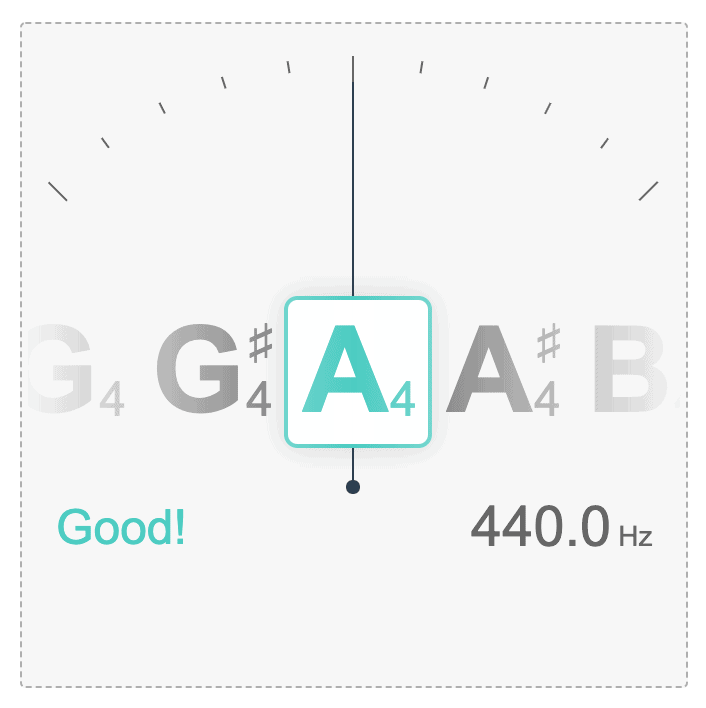
Before you can use a tuner to check your intonation, there are two other things you should learn first:
1. You Should Understand Which Notes You Are Playing
If you do not know which note you are trying to play, you won’t know if the tuner is displaying the correct note. If you are in doubt about what note you are playing, I have created an easy cheat sheet with all the violin notes in the first position. With this chart, you can easily check which notes are displayed in your sheet music. You can download it here:
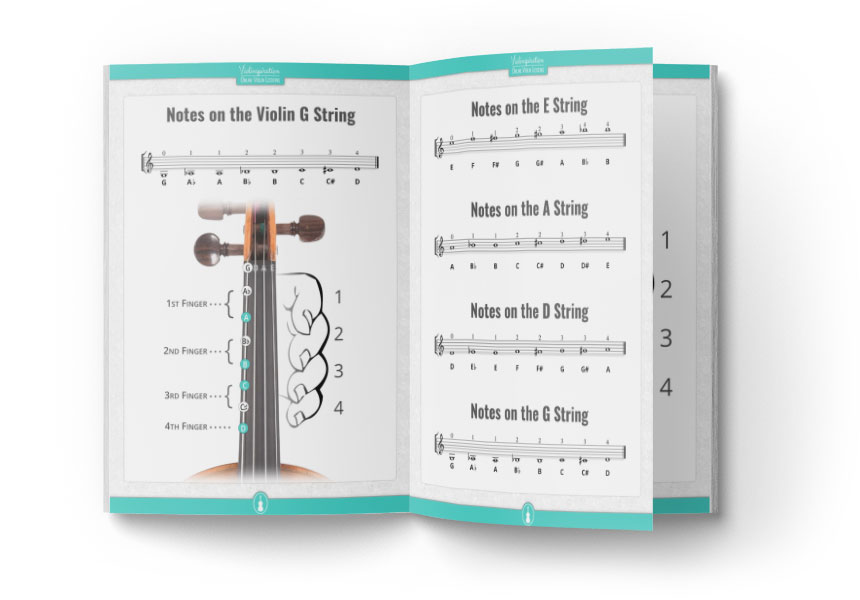
Get your free Fingering Charts
of All Violin Notes
2. You Should Be Able to Make a Reasonably Quality Bow Stroke
If you are not making a consistent bow stroke, the tuner needle will keep pointing in many different directions.
In order to learn to make a quality bow stroke, I recommend playing bow strokes in front of the mirror on open strings.
Also, take a look at this video lesson in which I share how to get rid of squeaky sounds.
InTune Pitch Analyzer
One downside of using a violin tuner to check your pitch is that the pointer often moves back and forth around the pitch, almost never landing exactly on the pitch. This makes it harder to tell if you are still in the correct pitch range.
In Julia’s Violin Academy, one feature available for all members is a pitch analyzer called InTune.
The great thing about InTune is that it gives you direct feedback if a note is in tune or not, without needing to guess if it is good enough from a moving needle. Claude (the programmer of the software) and I have decided together what the “correct range” is. If you keep playing in the correct range, your intonation will be marked as green (correct).
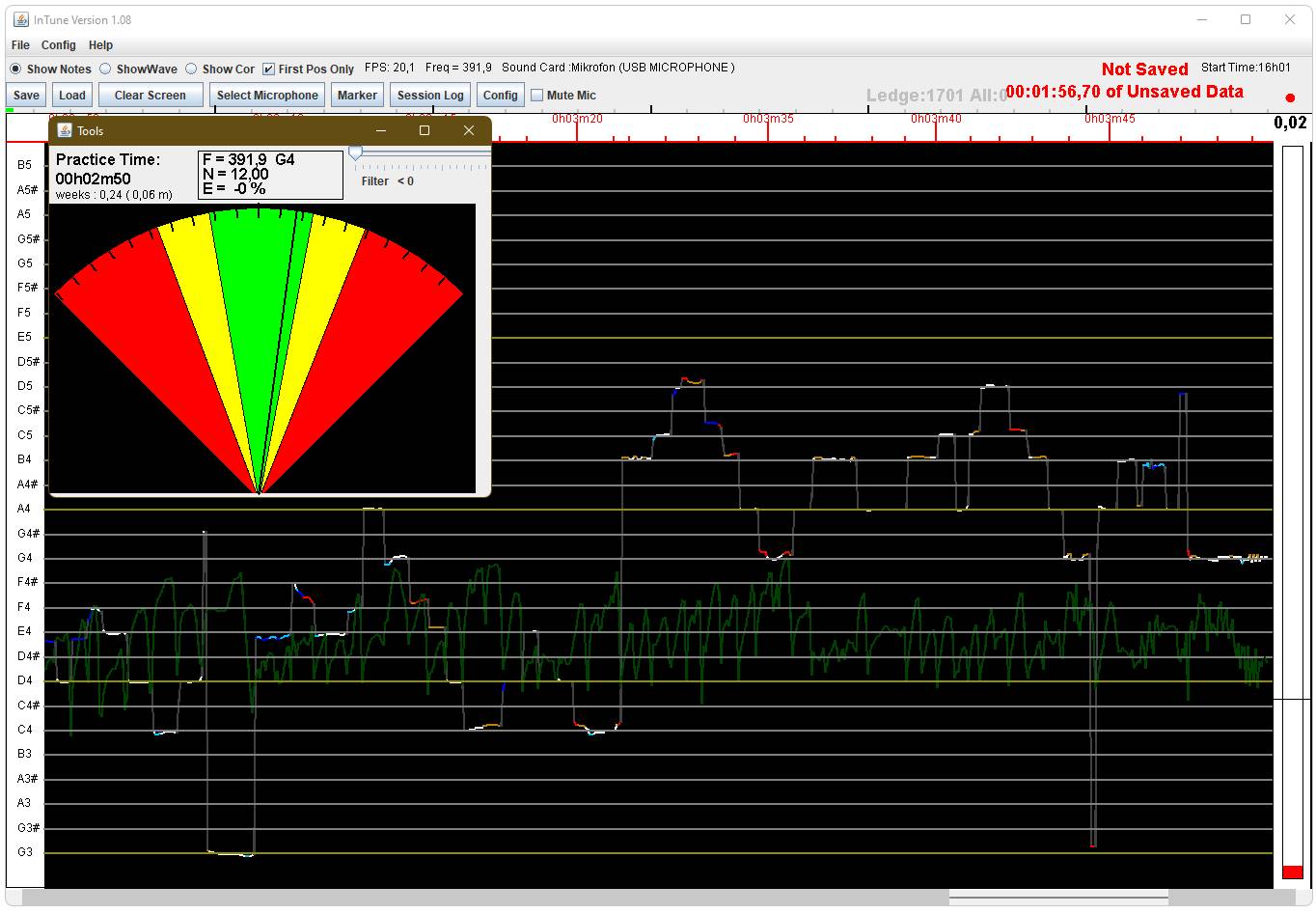
If you are playing a note too low or too high, you will see a yellow or red line displayed. At the end of a practice session, it shows you the results of how many notes you played in tune. It also tells you which notes you play out of tune, and how to adjust your intonation (either lower or higher).
You can try out InTune and all the other features of JVA by becoming a member of Julia’s Violin Academy – or access InTune directly from this link if you are already a member.
3. Compare Fingered Notes to the Open Strings
The open strings are another great help in checking whether your intonation is correct.
You can use the open strings to check the intonation of your third and fourth fingers.
Checking Fourth Finger Intonation
First of all, you can use the open strings to compare the intonation of the fourth finger. As I have mentioned in the countless free violin lessons on this website, the fourth finger on a string is always the same note as the open string above it.
This is of great benefit for you if you are in doubt about your fourth finger intonation. Just play the fourth finger at the same time as the string above. If it sounds like the same note, your intonation is correct!
On the other hand, if you start longing for some earplugs, you will have to keep adjusting your fourth finger until you have found the correct location.
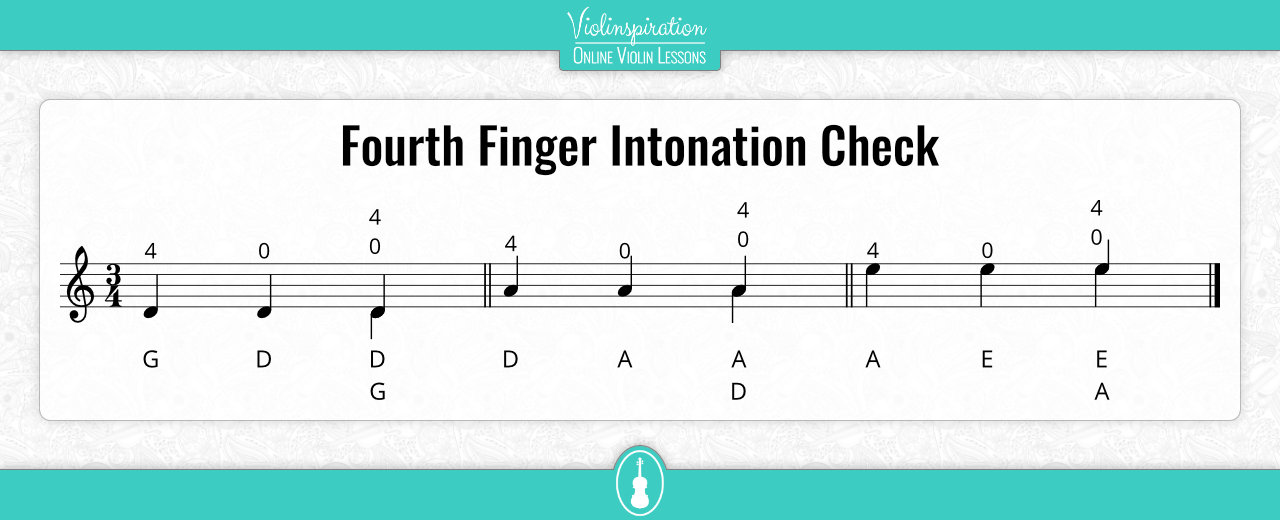
Checking Third Finger Intonation
The third finger intonation can be checked in a similar way to the fourth finger intonation.
You can check the intonation of the third finger by playing the third finger note and the string below.
If the two sound in perfect harmony, your third finger intonation is good to go!
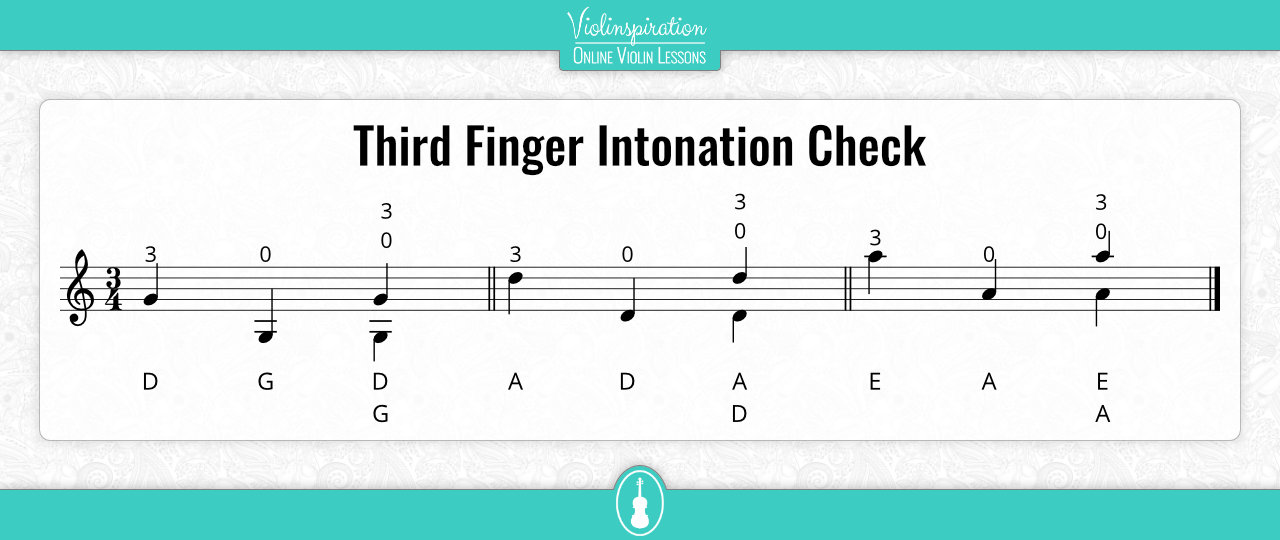
4. In Case of Doubt, Ask a More Experienced Musician
In case you’d like some direct feedback on how good your intonation currently is, asking another musician or even your violin teacher is a great option.
Your violin teacher will be able to tell you which notes you are playing in tune, and which fingers still need to adjust. If you are a member of Julia’s Violin Academy, you can also submit your video for feedback and ask us to analyze your intonation for you. Please don’t be shy!
Do violinists Use Just Intonation?
Violinists can use all types of intonation, but usually use either Pythagorean tuning/intonation or just intonation. Violinists use Pythagorean intonation for the majority of pieces, scales, and exercises. The only exception is when playing thirds, sixths, tenths, and chords – in that case, violinists use just intonation to ensure a perfect sounding double stop.
Very rarely do violinists also use equal temperament. Equal temperament is used in special cases if a violinist is playing together with another instrument that is tuned in equal temperament, such as the piano. If both instruments are playing a different part (e.g., violin with piano accompaniment), violinists will stick to Pythagorean intonation. If both instruments are playing the same note or passage, the violin will adapt to equal temperament.
How Can I Improve My Violin Intonation?
This is a question I could write a full article about – and I did!
In my article “12 Best Tips to Improve Your Violin Intonation” I share the 12 ways I recommend to improve your intonation.
As well as reading this article, you might also want to try studying your violin intonation with my recommended intonation exercises and etudes. These will give you a concrete idea about what types of exercise you could do during your intonation practice sessions.
Final Note
I hope that with this article, I am able to answer all the burning questions that you have about violin intonation.
If there is any question that has been left unanswered, please let me know in the comments! I will try to answer as many questions as possible in the days after publishing this blog post and beyond.
























